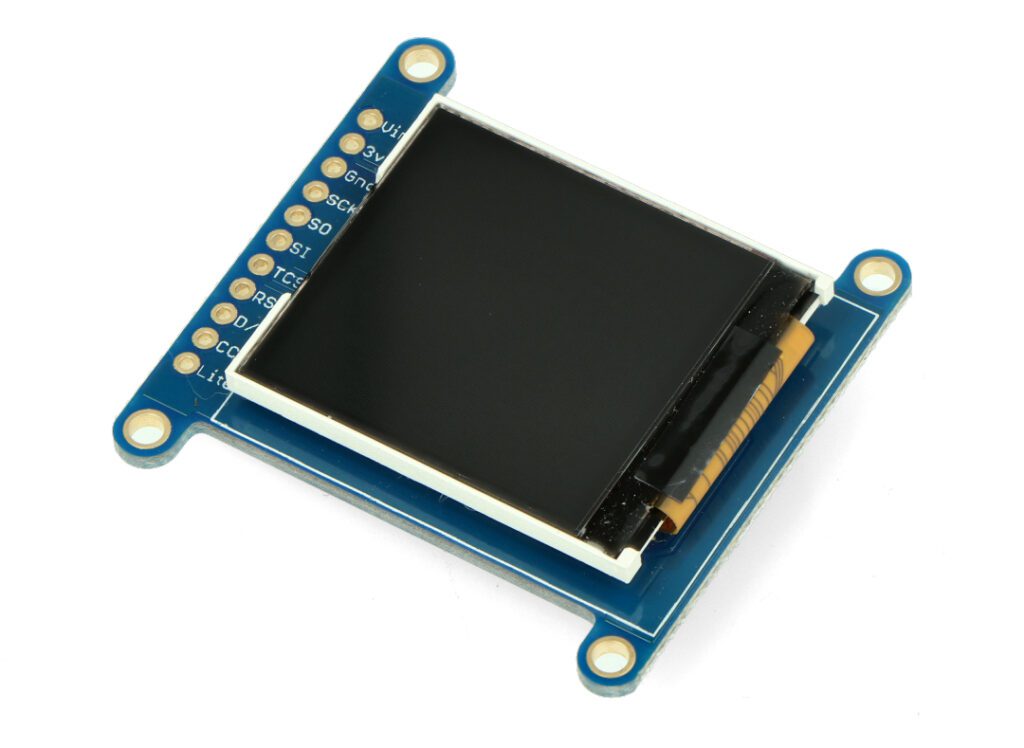Table of Contents:
A TFT (Thin Film Transistor) display is a specific type of liquid crystal display that until recently was commonly used in TVs, smartphones, tablets and computer monitors.
Basic information about TFT displays
With the launch of the displays
LED
i
OLED
, the share of
TFT screens
has been steadily declining. Nevertheless, TFT technology is still in use. The principle of this type of display is to change the polarity of light. This effect occurs due to a change in the orientation of small molecules of liquid crystal that move under the influence of an electric field.
TFT displays
consist of 4 basic components. The first is a polarizing filter, whose main task is the so-called “polarizing filter”. pre-polarization of light. The second element is a glass electrode responsible for controlling the orientation of the liquid crystal particles. The third element is a layer of liquid crystal that responds to an electric field by changing the polarization of light. The final component is a light analyzer. The task of this subassembly is to transmit light only of a certain polarization.
A brief historical overview of TFT displays
The origins of TFT displays date back to the second half of the 20th century. That’s when the first scientists began experimenting with thin-film transistors. In a relatively short time, the first miniature TFT displays were developed. However, the initial models had very limited use. They were mainly used in science. Early 1980s. The 1970s represented a breakthrough for liquid crystal displays. The slim design, combined with low power requirements meant that the screens began to be massively implemented in mobile devices.
In the following years, touch technology developed, making TFT displays even more popular. Continuous work on improving backlight technology has resulted in displays with improved contrast and extended life.
How do TFT displays work?
The way it works
displays made with TFT technology
relies on precise control of the amount of light that passes through the liquid crystal layer. The controlling elements are diodes that determine which specific pixels should be dark and which should be light. This is how the image is created.
Advantages of TFT displays
TFT displays provide high quality and detailed images. In addition, they are distinguished by their ability to display high-resolution images. Another advantage is the low demand for electricity. A specific type of TFT displays are models made with LTPS-TFT technology. The key advantages of models of this type are low weight, slim design, wide integration and even lower power requirements.
Disadvantages of TFT displays
The major drawbacks of displays made with TFT technology include mediocre reproduction of dark colors and limited viewing angles. Displays of this type are prone to overexposure of gray (especially for black). In addition, during prolonged static display, the screens tend to “pixel burn-in.” Although this phenomenon does not occur very often, it should be kept in mind.
Differences between TFT and OLED displays
The most important differences between TFT and OLED (Organic Light Emitting Diode) displays include construction and operation. In a nutshell, the principle of OLED screens is to emit light through organic semiconductor materials. Light is produced when current flows through these materials. This means that each pixel just emits light, so there is no need for backlighting. For this reason, the image emitted by OLED displays is distinguished by deep blacks, excellent contrast and wide viewing angles.
Another difference between TFT and OLED screens is the production price. OLED models are more complicated and more expensive to produce, and thus to sell. A good example is OLED TVs, which are significantly more expensive than models with TFT displays.
TFT screens compatible with Rasberry Pi minicomputer
TFT resistive screens
Compatible with selected versions of the minicomputer
Raspberry Pi
are often used for DIY projects. Depending on the specific model, the displays can be equipped with SPI and GPIO communication interfaces. In turn, the XPT2046 controller is mostly responsible for managing the touch function. There are displays on the market with a diagonal of, for example, 3.5″ and a resolution of 320 pixels x 480 pixels. They can be used, for example, to display text and menus.
Also worth noting are capacitive screens from the brand Waveshare compatible with Rasberry Pi, starting with the Zero model, through 1A,1B, 1B+, 2B, 3B+, and 4B. Selected models have a diagonal of as much as 10.1″ and a resolution of 1024 px x 600 px. In everyday use, this means excellent sharpness and detail of the displayed image. Included, in addition to the screen itself, is a special HDMI control board to ensure compatibility with Raspberry.
How to choose a TFT display?
When choosing a particular model of display made with TFT technology, pay close attention to the technical parameters. The first is resolution. The larger it is, the more detailed and clear the image is. Of course, this applies to screens of identical diagonal and different resolution.
Another important parameter is contrast, which is the difference between the darkest and brightest points of the display. The higher the screen contrast, the better. The viewing angles are also worth reviewing. This parameter is responsible for the ability to use the screen at different angles without reducing the quality and brightness of the displayed image. Other parameters include color reproduction and maximum brightness.
How useful was this post?
Click on a star to rate it!
Average rating 0 / 5. Vote count: 0
No votes so far! Be the first to rate this post.




















